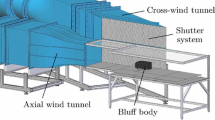Abstract
A test facility has been constructed to realistically simulate the flow around a two dimensional car shaped body in a wind tunnel. A moving belt simulator has been employed to generate the relative motion between model and ground. In a first step, the aerodynamic coefficients c L and c D of the model are determined using static pressure and force measurements. LDA-measurements behind the model show the large vortex and turbulence structures of the near and far wake. In a second step, the ambient flow around the model is modified by way of an active flow control which uses the Coanda effect, whereby the base-pressure increases by nearly 50% and the total drag can be reduced by 10%. The recirculating region is completely eliminated. The current work reveals the fundamental physical phenomena of the new method by observing the pressure forces on the model surface as well as the time averaged velocities and turbulence distributions for the near and far wake. A theory resting on this empirical information is developed and provides information about the effectiveness of the blowing method. For this, momentum and energy equations were applied to the flow around the vehicle to enable a validation of the theoretical results using experimental values.
Similar content being viewed by others
Author information
Authors and Affiliations
Additional information
Received: 9 June 1998 / Accepted: 20 July 1999
Rights and permissions
About this article
Cite this article
Geropp, D., Odenthal, HJ. Drag reduction of motor vehicles by active flow control using the Coanda effect. Experiments in Fluids 28, 74–85 (2000). https://doi.org/10.1007/s003480050010
Issue Date:
DOI: https://doi.org/10.1007/s003480050010




